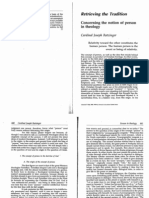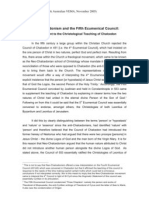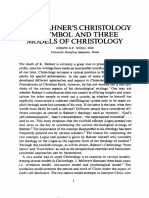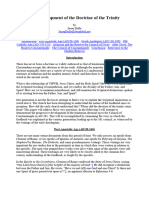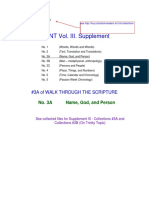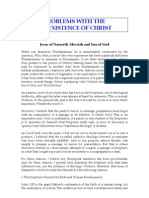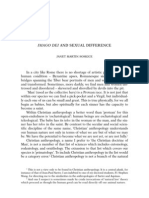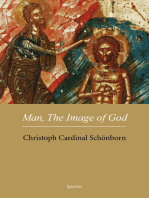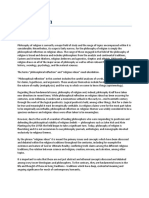0 ratings0% found this document useful (0 votes)
153 viewsRatzinger, Person
Ratzinger, Person
Uploaded by
grey0145This document discusses the origins of the concept of "person" in Christian theology. It argues that the concept arose from two central questions in early Christian thought: "What is God?" and "Who is Christ?". To answer these questions, Christian theologians adopted the ancient Greek word "prosopon" (persona in Latin), which originally just meant "role". Through a process of "prosopographic exegesis" of scripture, where God is portrayed as engaging in dialogue with himself and others, the early Church Fathers like Tertullian began using "prosopon" to represent real divine persons or hypostases, rather than just literary roles. This established the concept of person
Copyright:
© All Rights Reserved
Available Formats
Download as PDF, TXT or read online from Scribd
Ratzinger, Person
Ratzinger, Person
Uploaded by
grey01450 ratings0% found this document useful (0 votes)
153 views9 pagesThis document discusses the origins of the concept of "person" in Christian theology. It argues that the concept arose from two central questions in early Christian thought: "What is God?" and "Who is Christ?". To answer these questions, Christian theologians adopted the ancient Greek word "prosopon" (persona in Latin), which originally just meant "role". Through a process of "prosopographic exegesis" of scripture, where God is portrayed as engaging in dialogue with himself and others, the early Church Fathers like Tertullian began using "prosopon" to represent real divine persons or hypostases, rather than just literary roles. This established the concept of person
Original Description:
Joseph Ratzinger, Person in Theology
Copyright
© © All Rights Reserved
Available Formats
PDF, TXT or read online from Scribd
Share this document
Did you find this document useful?
Is this content inappropriate?
This document discusses the origins of the concept of "person" in Christian theology. It argues that the concept arose from two central questions in early Christian thought: "What is God?" and "Who is Christ?". To answer these questions, Christian theologians adopted the ancient Greek word "prosopon" (persona in Latin), which originally just meant "role". Through a process of "prosopographic exegesis" of scripture, where God is portrayed as engaging in dialogue with himself and others, the early Church Fathers like Tertullian began using "prosopon" to represent real divine persons or hypostases, rather than just literary roles. This established the concept of person
Copyright:
© All Rights Reserved
Available Formats
Download as PDF, TXT or read online from Scribd
Download as pdf or txt
0 ratings0% found this document useful (0 votes)
153 views9 pagesRatzinger, Person
Ratzinger, Person
Uploaded by
grey0145This document discusses the origins of the concept of "person" in Christian theology. It argues that the concept arose from two central questions in early Christian thought: "What is God?" and "Who is Christ?". To answer these questions, Christian theologians adopted the ancient Greek word "prosopon" (persona in Latin), which originally just meant "role". Through a process of "prosopographic exegesis" of scripture, where God is portrayed as engaging in dialogue with himself and others, the early Church Fathers like Tertullian began using "prosopon" to represent real divine persons or hypostases, rather than just literary roles. This established the concept of person
Copyright:
© All Rights Reserved
Available Formats
Download as PDF, TXT or read online from Scribd
Download as pdf or txt
You are on page 1of 9
assumed in Christ and in the new law (on the basis of the
resolution of the eternal law into the Christic predestination),
and that which is assumed is not abolished: quod est assumpturn
est senmtum. To one who does not believe, it is always possible
to demonstrate the intrinsic reasonableness of a norm which is
knowable even naturally, without failing from the beginning to
present it as an ingredient of a whole which receives its full
foundation only jn the Chdstic perspective.
Retrieving the Tradition
Concerning the notion of person
in theology
Cardinal Joseph Ratzinger
Relativity toward the other constitutes the
human person. The human person is the
event or being of relativity.
The concept of person, as well as the idea that stands behind
this concept, is a product of Christian theology. In other words,
it grew in the first place out of the interplay between human
thought and the data of Christian faith and so entered intellec-
tual history. The concept of the person is thus, to speak with
Gilson, one of the contributions to human thought made pos-
sible and provided by Christian faith. It did not simply grow
out of mere human philosophizing, but out of the interplay
between philosophy and the antecedent given of faith, espe-
cially Scripture. More specifically, the concept of person arose
from two questions that have from the very beginning urged
themselves upon Christian thought as central: namely, the
question, 'What is God?" (i.e., the God whom we encounter in
Scripture); and, "Who is Christ?" In order to answer these
fundamental questions that arose as soon as faith began to re-
flect, Christian thought made use of the philosophically insig-
nificant or entirely unused concept "prosopon" = " persona." It
thereby gave to this word a new meaning and opened up a new
dimension of human thought. Although this thought has dis-
tanced itself far from its origin and developed beyond it, it
nevertheless lives, in a hidden way, from this origin. In my
Communio $ (Fall, 1990). el990 by Communio: lnternaiional Catholic Review
440 Cardinal Joseph Ratzinger
judgment one cannot, therefore, know what "person"' most
truly means without fathoming this origin.
For this reason please forgive me because, al-
though I was asked to talk as a systematic theologian about the
dogmatic concept of the person, I will not present the latest
ideas of modern theologians. Instead, I will attempt to go back
to the origin, to the source and ground from which the idea of
"person" was born and without which it could not exist. The
outline flows from what was said above. We will simply take a
closer look at the two origins of the concept of person, its origin
in the question of God and its origin in the question of Christ.
I. The concept of person in the doctrine of God Lp
A. The origin of the concept of person
The first figure we meet is that of the great Western
theologian Tertullian. Tertullim'shaped Latin into a theological
language and, with the almost incredible sureness of a genius,
he knew how to develop a theological terminology that re-
mained unsurpassable in later centuries, because already on
the first attempt it gave form permanently to valid formulae of
Christian thought. Thus it was Tertullian who gave to the West
its formula for expressing the Christian idea of God. God is
"una substantia-tres personae," one being in three persons.1 It
was here that the word "person" entered intellectual history
for the first time with its full weight.
It took centuries for this statement to be intellectu-
ally penetrated and digested, until it was no longer a mere
statement, but truly a means of reaching into the mystery,
teaching us, not, of course, to comprehend it, but somehow to
grasp it. When we realize that Tertullian was able to coin the
phrase while its intellectual penetration was still in its infancy,
the question arises, How could he find this word with almost
somnambulant sureness? Until recently, this was a puzzle. Carl
Andresen, historian of dogma at Gottingen, has been able to
solve this puzzle so that the origin of the concept of person, its
'The final formula of the West was una essentia-tres personae; TertuUian had
said, una su bstan tia--t personae, Augustine una essen tia-tres su bstan tiae.
I
Person in theology 441
true source and ground,/ is somewhat clear to us today? The
answer to the question of the origin of the concept "person" is
that it originated in "prosopographic exegesis." What does this
mean? In the background stands the word prosopon, which is
the Greek equivalent of persona. Prosopographic exegesis is a
form of interpretation developed already by the literary schol-
ars of Antiquity. The ancient scholars noticed that in order to
give dramatic: life to events, the great poets of Antiquity did not
simply narrate these events, but allowed persons to make their
appearance and to speak. For example, they placed words in
the mouths of divine figures and the drama progresses through
these words. In other words, the poet creates the artistic device
of roles through which the action can be depicted in dialogue.
The literary scholar uncovers these roles; he shows that the
persons have been created as "roles" in order to give dramatic
life to events (in fact, the word "prosopon," later translated by
I1
persona," originally means simply "role," the mask of the
actor). Prosopographic exegesis is thus an interpretation that
brings to light this artistic device by making it clear that the
author has created dramatic roles, dialogical roles, in order to
give life to his poem or narrative.
In their reading of Scripture, the Christian writers
came upon something quite similar. They found that, here too,
events progress in dialogue. They found, above all, the peculiar
fact that God speaks in the plural or speaks with himself (e.g.,
"Let us make man in our image and likeness," or God's stat-
ment in Genesis 3, "Adam has become like one of us," or Psalm
110, "The Lord said to my Lord which the Greek Fathers take
to be a conversation between God and his Son). The Fathers
approach this fact, namely, that God is introduced in the plural
as speaking with himself, by means of prosopographic exegesis
which thereby takes on a new meaning. Justin, who wrote in
the first half of the second century (d. 165), already says "The
sacred writer introduces different prosopa, different roles."
However, now the word no longer really means "roles," be-
cause it takes on a completely new reality in terms of faith in
the Word of God. The roles introduced by the sacred writer are
realities, they are dialogical realities. The word "prosopon" =
... :
'C. ~ndresen, . +~ur Entstehung und Geschichte des trinitarischen Person-
begiffs," ZNW 52 (1961): 1-38. The Patristic texts ated below are taken from
Andresen's article.
442 Cardinal Joseph Ratzinger
"role" is thus at the transitional point where it gives birth to-the
idea of person. I will cite merely one text by Justin to danfy this
process. "When you hear that the prophets make statements as
if a person were speaking (hos apo prosopou), then do not sup-
pose that they were spoken immediately by those filled with
the spirit (i.e., the prophets) but rather by the Logos who moves
them."3 Justin thus says that the dialogical roles introduced by
the prophets are not mere literary devices. The "role" truly
exists; it is the prosopon, the face, the person of the Logos who
truly speaks here and joins in dialogue with the prophet. It is
qute clear here how the data of Christian faith transform and
renew a pre-given ancient schema used in interpreting texts.
The literary artistic device of letting roles appear to enliven the
narrative with their dialogue reveals to the theologians the one
who plays the true role here, the Logos, the prosopon, the person
of the Word which is no longer merely role, but person.
About .fifty years later, when Tertullian wrote his
works, he was able to go back to an extensive tradition of
such Christian prosopographic exegesis in which the word
prosopon = persona had already found its full claim to reality.
Two examples must suffice. In Adversus Praxean, Tertdian
writes, "How can a person who stands by himself say, 'Let us
make man in our image and likeness,' when he ought to have
said, 'Let memake man in my image and likeness,' as someone
who is single and alone for himself. If he were only one and
single, then God deceived and tricked also in what follows
when h e says, 'Behold, Adam has become like one bf us,'
which he said in the plural. But he did not stand alone, because
there stood with him the Son, his Word, and a third person,
the Spirit in the Word. This is why he spoke in the plural, 'Let
us make' and 'our' and 'us.'"4 One sees how the phenomenon
of intra-divine dialogue gives birth here to the idea of the per-
son who is person in an authentic sense. Tertullian similarly
says in his interpretation of "The Lord said to my Lord" (Psalm
110:1), "Take note how even the Spirit as the third person
speaks of the Father and of the Son, 'The Lord said to my Lord,
sit at my right hand until I put your enemies at your feet.'
Likewise through Isaiah, 'The Lord says these words to my
Lord Christ.'. . . In these few texts the distinction within the
qext cited by Andresen, rliid., 12.
4Adv. Prax. 12,l-3; Corpus Chris tianorum Il, 1172f .; Andresen, 10-21.
Person in theology 443
Trinity is dearly set before our eyes. For himself exists the one
who speaks, namely, the Spirit; further the Father to whom he
speaks, and inally the Son of whom he speaks."s
I do not wish to enter into the historical details of
these texts. I will merely summarize what results from them for
the issue of the idea "person." First, the concept "person"
grew out of reacling the Bible, as something needed for its
interpretation. It is a product of reading the Bible. Secondly, it
grew out of the idea of dialogue, more specifically, it grew as an
explanation of the phenomenon of the God who speaks dia-
logically. The Bible with its phenomenon of the God who
speaks, the God who is in dialogue, stimulated the concept
' I person." The particular interpretations of Scripture texts of-
fered by the Fathers are certainly accidental and outdated. But
their exegetical direction as a whole captures the spiritual di-
rection of the Bible inasmuch as the fundamental phenomenon
into which we are placed by the Bible is the God who speaks
and the human person who is addressed, the phenomenon of
the partnership of the human person who is called by God to
love in the word. However, the core of what "person" can truly
mean comes thereby to light. To summarize we can say: The
idea of person expresses in its origin the idea of dialogue and
the idea of God as the dialogical being. It refers to God as the
being that lives in the word and consists of the word as "I" and
"you" and "we." In the light of this knowledge of God, the
true nature of humanity became clear in a new way.
B. Person as relation
The first stage of the struggleefor the Christian con-
cept of God has been sketched above. I want to add a brief look
'Adv. Prax. 11,7-10; ibid., 1172. In my judgment it would be important to
investigate. the rabbinic antecedents of this prosopographic exegesis. Inter-
esting relevant material is found in E. Sjoberg, "Geist im Judentum," ThWNT
6.385ff. Sjijberg shows that in rabbinic literature the Holy Spirit is often de-
picted in personal categories: he speaks, cries, admonishes, mourns, weeps,
rejoices, consoles, etc. He is also portrayed as speaking to God. Sjoberg notes
on this '3hat the stylistic device of personification and dramatization is typical
for rabbinic literature" and "that the pesonal reaction of the Spirit is always
tied to words of.Sacred Scripture" (p. 386). A closer analysis of the texts could
perhaps show that the patristic elaboration of the concept of person does not
take its point of departure from the literary criticism of antiquity, but from
this .rabbinic exegesis.
I
H
0
8
3
s
0
4
-
J
G
B
.
d
2
.B
2
'
C
,
a
5
c
'
a
3
e
2
e
G
'
f
P
E
a
?
'
2
.
B
446 Cardinal Joseph Ratzinger Person in theology 447
One could go much further in following out this
line of the idea of relation and of relativity in John, and in
showing that it is the dominant theme of his theology, at any
rate of his Christology. I want to mention only two examples.
John picks up the theology of mission found in the Synoptics
and in the Judaism of antiquity in which the idea is already
formulated that the emissary, inasmuch as he is an emissary, is
not important in himself, but stands for the sender and is one
with the sender. John extends this Je-%sh idea of mission,
which is at first a merely functional idea, by depicting Christ as
the emissary who is in his entire nature "the one sent." The
Jewish principle, "The emissary of a person is like that person"
now takes on a completely new and deepened s i ~ c a n c e ,
because Jesus has absolutely nothing besides being the emis-
sary, but is in his nature "the one sent." He is like the one who
sent him precisely because he stands in complete relativity of
existence toward the~one who sent him. The content of the
Johannine concept "the one sentr' could be described as the
absorption of being in "being from someone and toward some-
one." The content of Jesus' existence is "being from someone
and toward someone," the absolute openness of existence
without any reservation of what is merely and properly one's
own. And again the idea is extended to Christian existence of
which it'is said, "As the Father has sent me, so I am sending
you" (20:21). The other example is the doctrine of the Logos, the
concept of the Word which is applied to Jesus. Once again, John
picks up a schema of theological thought that was extremely
widespread in the Greek and Jewish world. Of course, he
thereby adopts a whole series of contents that are already de-
veloped therein and he applies them to Christ. However, there
was a new element he introduced into the concept of the Logos.
In important respects, what was decisive for him was not so
much the idea of an eternal rationality-as among the Greeks,
or whatever other speculation there may have been; what was
decisive was much rather the relativity of existence which lies
in the concept of the Logos.
For again, the point is that a word is essentially
from someone else and toward someone else; word is existence
that is completely path and openness. Some texts express this
idea differently and clanfy it, for instance when Christ says:
"My teaching is not my teaching" (7:16). Augustine offers a
marvellous commentary on this text by asking: Is this not a
contradiction? It is either my teaching or not. He h d s an an-
swer in the statement, Christ's doctrine is he himself, and he
himself is not his own, because his "I" exists entirely from the
"you." He goes on to say, "Quid tam tuum quam tu, quid tam non
tuum quam tu-what beongs to you as much as your 'I,' and
what belongs to you as little as your 'I?"' Your "I" is on the one
hand what is most your own and at the same time what you
have least of yourself; it is most of all not your own, because it
is only from the "you" that it can exist as an "I" in the first
place.
Let us summarize: in God there are three persons-
which implies, according to the interpretation offered by the-
ology, that persons are relations, pure relatedness. Although
, this is in the first place only a statement about the Trinity, it is
at the same time the fundamental statement about what is at
stake in the concept of person. It opens the concept of person
into the human spirit and providesits foundation and origin.
One final remark on this point. As already indi-
cated, Augustine explicitly transposed this theological affirma-
tion into anthropology by attemptingto understand the human
person as an image of the Trinity in terms of this idea'of God.
Unfortunately, however, he committed a decisive mistake here
to which we will come back later. In his interpretation, he
projected the divine persons into the interior life of the human
person and affirmed that intra-psychic processes correspond to
these- persons. The person as a whole,by contrast, corresponds
to the divine substance. As a result, the trinitarian concept of
person was no longer transferred to the human person in all its
immediate impact. However, at present we can merely hint at
this point; it wiU become clearer below.
11. The concept of person in Christology
The second origin of the concept of person lies in
Christology. In order to find its way through difficult problems,
theology again used the word persona and thus gave the human
mind a new task. Theology answered the riddle, "Who and
what is this Christ?" by means of the formula, "He has two
natures and one person, a divine and a human nature, but only
a divine person." Here again the word persona is introduced.
One must say that this statement suffered from tremendous
misunderstandings in Western thought. These misunderstand-
. ings must be removed first, in order to approach the authentic
m e a ~ g of the Christological concept of person. The first mis-
0
h
m
a
a
X
b
.
B
c
r
@
,
$
,
I
7
0
6
%
+
'
p
$
'
~
-
w
&
a
g
.
3
.
s
.
"
&
-
g
3
s
z
a
M
E
M
I
@
^
+
^
3
a
a
.
r
a
%
2
c
.
o
%
.
L
.
+
s
i
a
,
{
g
c
g
~
a
,
~
~
a
8
$
.
L
*
F
;
&
m
a
A
a
x
g
z
s
g
.
5
8
2
G
o
,
3
I
p
q
W
0
-
2
3
5
6
6
,
.
$
8
-
+
h
A
2
*
g
m
s
s
3
2
o
d
.
-
4
,
%
j
m
'
3
3
3
2
'
0
o
p
a
7
-
3
G
a
c
r
.
$
0
0
a
3
'
8
B
2
1
~
s
E
Y
a
a
u
o
a
a
g
o
g
5
8
3
e
B
E
a
m
2
2
g
:
;
2
5
,
,
0
-
2
$
3
e
3
s
$
4
a
i
d
3
%
,
+
%
6
.
7
.
u
u
a
A
-
m
m
w
g
C
%
a
m
0
a
7
U
~
e
~
g
8
s
o
a
~
-
w
7
*
$
F
;
m
A
a
a
%
0
m
c
r
0
m
%
8
m
g
m
s
-
g
l
g
&
q
s
e
e
i
a
8
u
8
8
#
S
450 Cardinal Joseph Ratzinger
!
I
Person in theology 451
, .
derstaflding radioactivity as an anomaly."7 Something meth-
odologically decisive for all human thinking becomes visible
here. The seeming exception is in reality very often the symp
tom that shows us the insufficiency of our previous schema of
order, which helps us to break open this schema and to con-
quer a new realm of reality. The exception shows us that we
have built OLE closets too small, as it were, and that we must
break them open and go on in order to see the whole.
This is the meaning of Christology from its origin:
what is disclosed in Christ, whom faith certainly presents as
unique, is not only a speculative exception; what is disclosed in
truth is what the riddle of the human person really intends.
Scripture expresses this point by calling Christ the last Adam or
"the second Adam." It thereby characterizes him as the true
fulfillment of the idea of the human person, in which the di-
rection of meaning of this being comes fully to light for the first
time. If it is true, however, that Christ is not the ontological
exception, if from his ezceptional position he is, on the con-
trary, the fulfillment of the entire human being, then the Chris-
tological concept of person is an indication for theology of how
person is to be understood as such. In fact, this conce t of
person, or simply the dimension that has become visible K ere,
has always acted as a spark in intellectual history and it has
propelled development, even when it had long come to a
standstill in theology.
After these two fundamental misunderstandings
have been rejected, the question remains, What does the for-
mula mean positively, "Christ has two natures in one person?"
I must admit right away that a theological response has not yet
completely matured. In the great struggles of .the first six cen-
turies, theology worked out what the person is not, but it did
not clarify with the same definiteness what the word means
positively. For this reason I can only provide some hints that
point out the direction in which reflection should probably
continue.
!
1 I believe two points can be made. a) It is the nature
of spirit to put itself in relation, the capacity to see itself and the
,
other. Hedwig Conrad-Martius speaks of the retroscendence of
i
the spirit: the spirit is not merely there; it goes back upon itself,
I
as it were; it knows about itself; it constitutes a doubled exist-
ence which not only is, but knows about itself, has itself. The
: . difference between matter and spirit would, accordingly, con-
sist in this, that matter is what is "das auf sich Geworfole" (that
which is thrown upon itself), while the spirit is "das sich selbst
Entwerfende" (that which throws itself forth, guides itself or
designs itself) which is not only there, but is itself in transcend-
ing itself, in looking toward the other and in looking back upon
I
itself.9 However this may be in detail-we need not investigate
I
it here-openness, relatedness to the whole, lies in the essence
E
1
of the spirit. And precisely in this, namely, that it not only is,
I
but reaches beyond itself, it coqes to itself. In transcencling
i
itself it has itself; by being with the other it first becomes itself,
it comes to itself. Expressed differently again: being with the
i
other is its form of being with itself. One is reminded of a
fundamental theological axiom that is applicable here in a pe-
l
.,
culiar manner, namely Christ's saying, "Only the one who
I
I
loses himself can find himself" (cf. Mt . 10:36). This fundamen-
tal law of human existence, which'Mt. 10:36 understands in the
1
context of salvation, objectively characterizes the nature of the
1
spirit which comes to itself and actualizes its own fullness only
i
by going away from itself, by going to what is other than itself.
1' We must go one step further. The spirit is that
I .
i
being which is able to think about, not onlyitself and being in
1
i .
general, but the wholly other, the transcendent God. This is
j
perhaps the mark that truly distinguishes the human spirit
i
. I from other forms of consciousness found in animals, namely,
1
that the human spirit can reflect on the wholly other, the con-
1
i
cept of God. We may accordingly say: The other through
i
which the spirit comes to itself is finally that wholly other for
which we use the stammering word "God." If this is true, then
what was said above can be further clarified in the horizon of
r,
faith and we may say: If the human person is all the more with
7Quoted from Q. Tresmontant, Einfiihrung in das Denken Teilhard de Chardins
(Munich, 1961), 41f.
'on what follows, see. the instructive contribution of B. Welte, "Homoousios
bin,'" ina. Gdmeier and H. Bacht, Das Knozil von Chalcedon (vol. 3;
Wiirzbwg, 1954), 51-80; H. Conrad-Martius, DmSein (Munich, 1957). For the
patristic period, speciid mention should be made of Maximus the Confessor
by whom the positive clarification of the Christological concept of person was
pushed furthest; cf. H. U. von Balthasar, Kosmische Liturgie: Das Weltbild Max-
imus' des Bekenws (2nd ed.; Einsiedeln, 1961), 232-253.
%. -Conrad-Martius, Das Sein, 133.
2
8
,:
G
9
-
a
a
F
;
:
a
.
-
4
e
"
-
#
a
J
a
J
"
a
5
.
E
i
$
a
-
0
'
Z
G
*
5
.
.
+
.
5
?
.
s
-
2
:
:
3
2
*
.
a
8
4
2
.,
g
a
8
3
8
g
9
%
a
0
'
d
:a
-
2
3
P
I
:
454 Cardinal Joseph Ratzinger
ings, happened as a consequence sf the anthropological turn in
Augustine's doctrine of the Trinity and was one of the most
momentous developments of the Western Church. In funda-
mental ways it influenced both the concept of the Church and
the understanding of the person which was now pushed off
into the individualistically narrowed "I and you" that finally
loses the "you" in this narrowing. It was indeed a result of
Augustine's doctrine of the Trinity that the persons of God
were closed wholly into God's interior. Toward the outside,
God became a simple "I," and the whole dimension of "we"
lost its place in theology."l2 The individualized "I" and "you"
narrows itself more and more until finally, for example in
Kmt's transcendental philosophy, the "you" is no longer
found. In Feuerbach (and thus in a place where one would least
suspect it) this leveling of "I" and "you" into a single transcen-
dental consaousness gave way to the breakthrough to personal
reality. It thus gave the impetus to reflect more deeply on the
origin of our own being which faith recognizes as once and for
all disclosed in the word of Jesus the Christ.*-Translated by
Michael Waldstein
120n Augustine's doctrine of the Trinity up to 391, see 0. du Roy, L'intel-
ligence de la foi en la Trinifk selon Sf . Augustin (Paris, 1966); for the further
development, see M. Schmaus, Die psychologische Trinitiitslehre des heiligen
Augustinus (2nd ed.; Miinster, 1967). Today, of course, I would not judge as
harshly as I did in the lecture above, because for Augustine the "psycho-
logical doctrine of the Trinity" remains an attempt to understand which is
balanced by the factors of the tradition. The turn brought about by Thomas
through the separation of the doctrine of the one God and the theological
doctrine of the Trinity was more incisive. It led Thomas to consider the
formula "God is one person" legithate, although it had been considered
heretical in the early Chuch (Summa Theologica III, 3, 3 ad 1). On the subject
of the "we," see H. Miihlen, Der Heilige Geist als Person (2nd ed.; Miinster,
1967).
*This article reproduces a lecture given at a congress on the understanding
of the person in educational theory and related disciplines. The form of the
lecture was preserved with slight modifications. This origin explains the
sketchiness and preliminary nature of the text.-Author's note.
The article is a translation of the chapter, "Zum Personenversthdnis in der
Theologie," from Joseph Ratzinger, Dogma und Verkiindigung (Munich: Erich
Wewel Verlag, 1973), 205-223.-Ed.
Notes and
Comments
RELATION, THE THOMlSTlC
ESSE, AND AMERICAN
CULTURE: TOWARD A
METAPHYSIC OF SANCTITY
The debate which has arisen be-
tween George Weigel and David
Schindler over the bourgeois state of
America and its people can become
the catalyst for an analysis into
deeper things. Those deeper things
would be the question as to whether
human reality has as its ontological
prius substance, relation, or both. If
Schindler' i s correct i n his analysis of
Weigel,2 then America i s built, how-
ever unwittingly, on a kind of meta-
physic of substance which i s the in-
tellectual underpinning for a people
- -
'David Schindler, "Is America Bour-
geios?'Communio, vol. 14, no. 3 (Fall,
1987): 262-290; "Once Again: George
Weigel, Catholicism and American
Culture," Communio vol. 15, no. 1
(Spring, 1988): 92-1 21. See also, perti-
nent to our theme here, Schindler's
"Catholicity and the State of Contem-
porary Theology: The Need for an Onto-
logic of Holiness," Communio, vol. 14.
no. 4 (Winter, 1987): 426-450.
2George Weigel, "Is America Bour-
geois?" Crisis (October, 1 986); "Is
America Bourgeois? A Response to
David " Schindler," Communio 1 5
(Spring, 1988).
who do good, but are uncommitted
in their deepest selves to the service
of God and others. Their ontological
profile would be that of a self-con-
tained substance, in its deepest re-
cesses seeking self-fulfillment while
externally performing statistically
verifiable deeds of altruism and God-
centeredness. In a word, they would
be a selfish people with a veneer of
do-goodism. If Schindler i s correct in
his own presentation and explication
of Cardinal Ratzinger's mind on the
topic, the dimension of relation has
to be included in the ontological pro-
file, not merely as an accident of sub-
stance, but as an equal category of
being which i s necessary to describe
reality. Such an analysis, although
provoked by Revelation, would be
metaphysical. It would be telling us
that the notion of person, besides in-
cluding substance, must be formally
inclusive of relation. The notion of
person would take its meaning and
fulfillment from love. Person as such
could only take place in the plural, in
the presence of another.
As a result, we would have a
metaphysic which would coincide
with the asceticism of sanctity. We
would have escaped from the two-
tiered world of the minimum-the
moral (based on the substance
whose primary exigency i s to be for
itself and in itself), and the maxi-
mum-sanctity (based on the now
merely superogatory relation which
consists i n being for the other). This
expansion of the notion of substance
alone into substance and relation
when dealing with the person evi-
dently has deep implications for the
meaning of secularization. If person
i s merely substance, an in set then
the actions whereby he or she relates
to others are all accidents which re-
You might also like
- Sheva Brachot English Hebrew and TranslitDocument2 pagesSheva Brachot English Hebrew and TranslitPastor Marcos Luz100% (2)
- Isopnishad Questions AnswersDocument8 pagesIsopnishad Questions Answersjkmadaan50% (4)
- Feminist PneumatologyDocument4 pagesFeminist PneumatologyDuan Gonmei88% (8)
- Ratzinger On ManDocument9 pagesRatzinger On ManBuddy SeedNo ratings yet
- 08 - Grabowski - Ler - CroppedDocument25 pages08 - Grabowski - Ler - CroppedGessione CunhaNo ratings yet
- 12 Neo-ChalcedonismDocument7 pages12 Neo-ChalcedonismPhilip KariatlisNo ratings yet
- The Union of God and Man in The Thought of Gregory of NazianzusDocument17 pagesThe Union of God and Man in The Thought of Gregory of Nazianzusakimel100% (1)
- Christ As WordDocument5 pagesChrist As WordPhilip KariatlisNo ratings yet
- Man (Chrestos Yannaras)Document29 pagesMan (Chrestos Yannaras)ikonographicsNo ratings yet
- Assignment On Holy TrinityDocument6 pagesAssignment On Holy Trinityjjpuliken0% (1)
- Relational GodDocument17 pagesRelational GodKaram Abu SehlyNo ratings yet
- Myth NT BruceDocument7 pagesMyth NT BruceLazar Pavlovic100% (1)
- Deep Incarnation and Chalcedon On The enDocument33 pagesDeep Incarnation and Chalcedon On The enjimpetree6090100% (1)
- Karl Rahners ChristologyDocument25 pagesKarl Rahners Christologypunpun0586No ratings yet
- Lecture 8Document9 pagesLecture 8Chii Ing WongNo ratings yet
- The Bible and The TrinityDocument12 pagesThe Bible and The Trinityakimel100% (2)
- Von Balthasar, H.U.-on The Concept of PersonDocument5 pagesVon Balthasar, H.U.-on The Concept of PersonDaniel Augusto García PorrasNo ratings yet
- Benevich ProvidenceDocument10 pagesBenevich ProvidenceCiprian VasileNo ratings yet
- On Keeping "Persons" in The Trinity: A Linguistic Approach To Trinitarian ThoughtDocument19 pagesOn Keeping "Persons" in The Trinity: A Linguistic Approach To Trinitarian ThoughtLIto LamonteNo ratings yet
- Wisdom Christology in PaulDocument30 pagesWisdom Christology in PaulAlexander Yefta KansilNo ratings yet
- Hans Urs Von Balthasar - Concept of Person in TheologyDocument14 pagesHans Urs Von Balthasar - Concept of Person in Theologyineszulema100% (1)
- AEJT 4.5 DupucheDocument9 pagesAEJT 4.5 DupucheIoan-ovidiu CordisNo ratings yet
- Manifestation or IncarnationDocument9 pagesManifestation or IncarnationKiwiMarie8No ratings yet
- The Development of The Doctrine of The TrinityDocument13 pagesThe Development of The Doctrine of The TrinityK. LalthazualaNo ratings yet
- Coda - Per Un'Ontologia Trinitaria Della PersonaDocument15 pagesCoda - Per Un'Ontologia Trinitaria Della PersonaBear1976_ItalyNo ratings yet
- Stoicism and New TestamentDocument29 pagesStoicism and New Testamentmoseskabaso46No ratings yet
- Young JohnDocument8 pagesYoung JohnduyNo ratings yet
- Body FinalDocument30 pagesBody FinalHarley Dadia PigaNo ratings yet
- Chapter II. The First Christian Negative Theology: Justin and ClementDocument13 pagesChapter II. The First Christian Negative Theology: Justin and ClementJavier UgazNo ratings yet
- Walk Through The Scripture - Name, God, and PersonDocument259 pagesWalk Through The Scripture - Name, God, and PersonounbblNo ratings yet
- Problems With The Preexistence of ChristDocument9 pagesProblems With The Preexistence of Christapi-3755336No ratings yet
- The Doctrine of The Trinity - Its Development, Difficulties and ValueDocument27 pagesThe Doctrine of The Trinity - Its Development, Difficulties and Valueperodeformero100% (1)
- Transcendental and TrinityDocument12 pagesTranscendental and TrinityNur Diyana SallehuddinNo ratings yet
- Prophecy of Peter DeunovRobert Powell Harrie Salmanwith Image and RevisedDocument43 pagesProphecy of Peter DeunovRobert Powell Harrie Salmanwith Image and RevisedTeoNo ratings yet
- The Anatomy of GodDocument5 pagesThe Anatomy of GodashretejanoNo ratings yet
- The Trinitarian Personalism of St. Thomas Aquinas - Roland MillareDocument20 pagesThe Trinitarian Personalism of St. Thomas Aquinas - Roland Millarevnln_No ratings yet
- Christ Jesus - The Imago DeiDocument12 pagesChrist Jesus - The Imago DeiPedro Salazar EstevesNo ratings yet
- Thomas Aquinas DeoDocument36 pagesThomas Aquinas Deojoerald02 cailingNo ratings yet
- ChristologyDocument11 pagesChristologyRoy StewartNo ratings yet
- ANTI-CHRIST REVEALED Doug FortuneDocument3 pagesANTI-CHRIST REVEALED Doug FortuneChalo NdikoNo ratings yet
- Greek Exegesis of Colossians 1 15-20 TheDocument12 pagesGreek Exegesis of Colossians 1 15-20 ThecezargradinaruNo ratings yet
- Christ OlogyDocument37 pagesChrist OlogyEliezer Ramirez CastilloNo ratings yet
- Response To AyresDocument9 pagesResponse To AyresakimelNo ratings yet
- PanentheismDocument13 pagesPanentheismpatrick876No ratings yet
- Bernard Lonergan: On The Ontological and Psychological Constitution of ChristDocument3 pagesBernard Lonergan: On The Ontological and Psychological Constitution of Christpneumalogos1460No ratings yet
- Hecht, S. 2022. The Inner Man - Fundamental Concept of Pauline AnthropologyDocument16 pagesHecht, S. 2022. The Inner Man - Fundamental Concept of Pauline AnthropologypmgdottoNo ratings yet
- The Six Dawns by Dr. Alexander KalomirosDocument43 pagesThe Six Dawns by Dr. Alexander KalomirosMax RussoNo ratings yet
- Pneumatologies Balthasar RahnerDocument11 pagesPneumatologies Balthasar RahnerGarland HaneyNo ratings yet
- Imago Dei and Sexual Difference SoskiceDocument11 pagesImago Dei and Sexual Difference SoskicemdicksonNo ratings yet
- Nadams,+19760609 31 021-039Document19 pagesNadams,+19760609 31 021-039Boki KinnyNo ratings yet
- Theory and History of Ontology by Raul Corazzon - E-Mail: RC Ontology - CoDocument14 pagesTheory and History of Ontology by Raul Corazzon - E-Mail: RC Ontology - CoAj HonorNo ratings yet
- The Incarnation and The Holy TrinityDocument25 pagesThe Incarnation and The Holy TrinityakimelNo ratings yet
- The Holy Spirit and The Sanctification ADocument21 pagesThe Holy Spirit and The Sanctification AStefan SpinuNo ratings yet
- Law-And-Logos BermanDocument23 pagesLaw-And-Logos BermanAlicia HopkinsNo ratings yet
- Carmen Christi: Worshiping Christ As GodDocument20 pagesCarmen Christi: Worshiping Christ As GodEtienneNo ratings yet
- The Nature and Result of Literal InterpretationDocument13 pagesThe Nature and Result of Literal InterpretationAnonymous gtMsV5O6zHNo ratings yet
- Theo-Drama: Theological Dramatic TheoryFrom EverandTheo-Drama: Theological Dramatic TheoryRating: 4.5 out of 5 stars4.5/5 (4)
- Man, The Image of God: The Creation of Man as Good NewsFrom EverandMan, The Image of God: The Creation of Man as Good NewsNo ratings yet
- Milos Timotijevic Interwar Attitudes ofDocument46 pagesMilos Timotijevic Interwar Attitudes ofgrey0145No ratings yet
- Ambrose of Milan in The Byzantine TraditionDocument22 pagesAmbrose of Milan in The Byzantine Traditiongrey0145No ratings yet
- 1791 Sample PDFDocument15 pages1791 Sample PDFgrey0145No ratings yet
- 1376-Article Text-2803-1-10-19990401 PDFDocument17 pages1376-Article Text-2803-1-10-19990401 PDFgrey0145No ratings yet
- N A P S: Orth Merican Atristics OcietyDocument45 pagesN A P S: Orth Merican Atristics Ocietygrey0145No ratings yet
- Georges Florovsky, The Problem of Diaconate in The Orthodox ChurchDocument20 pagesGeorges Florovsky, The Problem of Diaconate in The Orthodox Churchgrey014550% (2)
- TorranceAC SCH Mark The MonkDocument10 pagesTorranceAC SCH Mark The Monkgrey0145No ratings yet
- Florovsky Archive Finding AidDocument106 pagesFlorovsky Archive Finding Aidgrey01450% (1)
- Between Umma and Dhimma. The ChristiansDocument34 pagesBetween Umma and Dhimma. The Christiansgrey0145100% (1)
- Personhood Cover PDFDocument4 pagesPersonhood Cover PDFgrey01450% (1)
- Why Did God Become Man by NellasDocument30 pagesWhy Did God Become Man by Nellasgrey0145100% (1)
- Philosophy of ReligionDocument122 pagesPhilosophy of ReligionAsrar NaqshbandiNo ratings yet
- Lavrin - A Note On Nietzsche and DostoevskyDocument12 pagesLavrin - A Note On Nietzsche and DostoevskyMarina Coelho SantosNo ratings yet
- Notes From Finding Darwin's God - Kenneth MillerDocument1 pageNotes From Finding Darwin's God - Kenneth MillerSamuel WatkinsonNo ratings yet
- Halloween Sunday School LessonDocument10 pagesHalloween Sunday School LessonMarisa MoseskhanNo ratings yet
- Swinburne R. - A Theodicy of Heaven and Hell (The Existence and Nature of God. Univ Notre Dame Pr. Pp. 37-54) - 1983Document10 pagesSwinburne R. - A Theodicy of Heaven and Hell (The Existence and Nature of God. Univ Notre Dame Pr. Pp. 37-54) - 1983Александр ДубоносовNo ratings yet
- Mysticism and Sexuality in Sufi Thought and LifeDocument13 pagesMysticism and Sexuality in Sufi Thought and Lifeh221031100% (2)
- SHS Introduction To World Religions and Beliefs ActivitiesDocument35 pagesSHS Introduction To World Religions and Beliefs ActivitiesFarinasIsisAngelicaPNo ratings yet
- Book Review Gods in Early BuddhismDocument1 pageBook Review Gods in Early BuddhismmahiyagiNo ratings yet
- DIZON - Stewardship Towards God's CreationDocument3 pagesDIZON - Stewardship Towards God's CreationCatherine Malabanan DizonNo ratings yet
- AtheistDocument43 pagesAtheistTopher PeridoNo ratings yet
- Lessons On IE1 Apostles Creed (Midterns)Document9 pagesLessons On IE1 Apostles Creed (Midterns)Darkevil CasterNo ratings yet
- In Your ArmsDocument54 pagesIn Your ArmsJenine VictorianoNo ratings yet
- Armageddon - The End Times Are Here Post Witchcraft RPGDocument258 pagesArmageddon - The End Times Are Here Post Witchcraft RPGggpeniche100% (19)
- BG Notes Gauranga Priya - Chap7Document27 pagesBG Notes Gauranga Priya - Chap7PranesvariDeviDasiNo ratings yet
- Nicholas BERDYAEV. Spirit and RealityDocument17 pagesNicholas BERDYAEV. Spirit and Realityr_medina_marrero100% (4)
- Nostradamus PropheciesDocument163 pagesNostradamus ProphecieshudiyaNo ratings yet
- Lesson 9: Loving God Living With GodDocument32 pagesLesson 9: Loving God Living With Godjin kimNo ratings yet
- The Pyramid ProphecyDocument41 pagesThe Pyramid ProphecyH_Wotan67% (3)
- Lesson 1 The Gospel MessageDocument2 pagesLesson 1 The Gospel MessageEFGNo ratings yet
- Prayers of The FaithfulDocument36 pagesPrayers of The FaithfulPhilip Jude Acidre100% (1)
- Are You One of GodDocument2 pagesAre You One of GodAdrian MassiahNo ratings yet
- Vol 1-Nigeria's ViolenceDocument160 pagesVol 1-Nigeria's ViolenceMarvin-Darlys McDonaldNo ratings yet
- NOVENA PRAYER Perpetual HelpDocument2 pagesNOVENA PRAYER Perpetual HelpRey LacsonNo ratings yet
- The Enemies of PotentialDocument20 pagesThe Enemies of PotentialAstrid von OldenburgNo ratings yet
- Embracing Your FemininityDocument28 pagesEmbracing Your FemininityCarlton FaceyNo ratings yet
- Under Loving CommandDocument12 pagesUnder Loving Commandfourbzboysmom100% (1)
- Mara-Yanka’s Newly Released “When the Angel Speaks, Listen” is a Soul-Stirring Call to Faith and Inner PeaceDocument3 pagesMara-Yanka’s Newly Released “When the Angel Speaks, Listen” is a Soul-Stirring Call to Faith and Inner PeacePR.comNo ratings yet
- Sozo Prayer Ministry Workshop 1 - A DEEPER RELATIONSHIP HandoutDocument7 pagesSozo Prayer Ministry Workshop 1 - A DEEPER RELATIONSHIP HandoutNathan HarveyNo ratings yet



